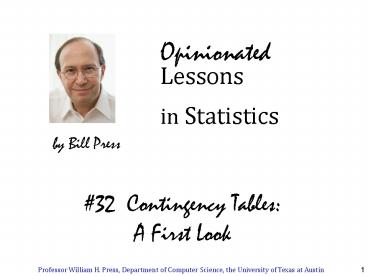Opinionated - PowerPoint PPT Presentation
1 / 7
Title:
Opinionated
Description:
Opinionated Lessons in Statistics by Bill Press #32 Contingency Tables: A First Look Contigency Tables, a.k.a. Cross-Tabulation Is alcohol implicated in malformations? – PowerPoint PPT presentation
Number of Views:56
Avg rating:3.0/5.0
Title: Opinionated
1
Opinionated
Lessons
in Statistics
by Bill Press
32 Contingency TablesA First Look
2
Contigency Tables, a.k.a. Cross-Tabulation
Is alcohol implicated in malformations? This kind
of data is often used to set public policy, so it
is important that we be able to assess its
statistical significance.
3
Contingency Tables (a.k.a. cross-tabulation) Ask
Is a gene is more likely to be single-exon if it
is AT-rich?
rowcon (g.ne 1) (g.ne gt 1) colcon
(g.atf lt 0.4) (g.atf gt 0.6) table
contingencytable(rowcon,colcon) table
2386 689 13369
3982 sum(table, 1) ans 15755
4671 ptable table ./ repmat(sum(table,1),2
1) ptable 0.1514 0.1475 0.8486
0.8525
(fewer genes AT rich than CG rich)
column marginals
So can we claim that these are statistically
identical?Or is the effect here also
significant but small?
my contingency table function
function table contingencytable(rowcons,
colcons) nrow size(rowcons,2) ncol
size(colcons,2) table squeeze(sum(
repmat(rowcons,1 1 ncol) . ...
permute(repmat(colcons,1 1 nrow),1 3 2),1 ))
4
Chi-square (or Pearson) statistic for contingency
tables
notation
expected value of Nij
null hypothesis
?
the statistic is
- Are the conditions for valid chi-square
distribution satisfied? Yes, because number of
counts in all bins is large. - If they were small, we couldnt use
fix-the-moments trick, because small number of
bins (no CLT). This occurs often in biomedical
data. - So what then? (We will return to this!)
table 2386 689 13369
3982
nhtable sum(table,2)sum(table,1)/sum(sum(table)
) nhtable 1.0e004 0.2372 0.0703
1.3383 0.3968 chis sum(sum((table-nhtable).2
./nhtable)) chis 0.4369 p
chi2cdf(chis,1) p 0.4914
d.f. 4 2 2 1
wow, cant get less significant than this! No
evidence of an association between single-exon
and AT- vs. CG-rich.
5
When counts are small, some subtle issues show
up. Lets look closely. The setup is
- The null hypothesis is Conditions and factors
are unrelated. - To do a p-value test we must
- Invent a statistic that measures deviation from
the null hypothesis. - Compute that statistic for our data.
- Find the distribution of that statistic over the
(unseen) population.
Thats the hard part! What is the population
of contingency tables? Well soon see that it
depends (maybe only slightly?) on the
experimental protocol, not just on the counts!
6
Lets review the hypergeometric distribution
What is the (null hypothesis) probability of a
car race finishing with 2 Ferraris, 2 Renaults,
and 1 Honda in the top 5 if each team has 6 cars
in the race and the race consists of only those
teams?
Hypergeometric probabilities have product of
chooses in the numerator, and a denominator
choose with sums of numerator arguments.
Out of N genes, m are associated with disease 1
and n with disease 2. What is the (null
hypothesis) probability of finding r genes
overlap?
Yes, it is symmetrical on m and n!
7
And now, review the multinomial distribution
On each i.i.d. try, exactly one of K outcomes
occurs, with probabilities
For N tries, the probability of seeing exactly
the outcome
probability of one specific outcome
is
number of equivalent arrangements

